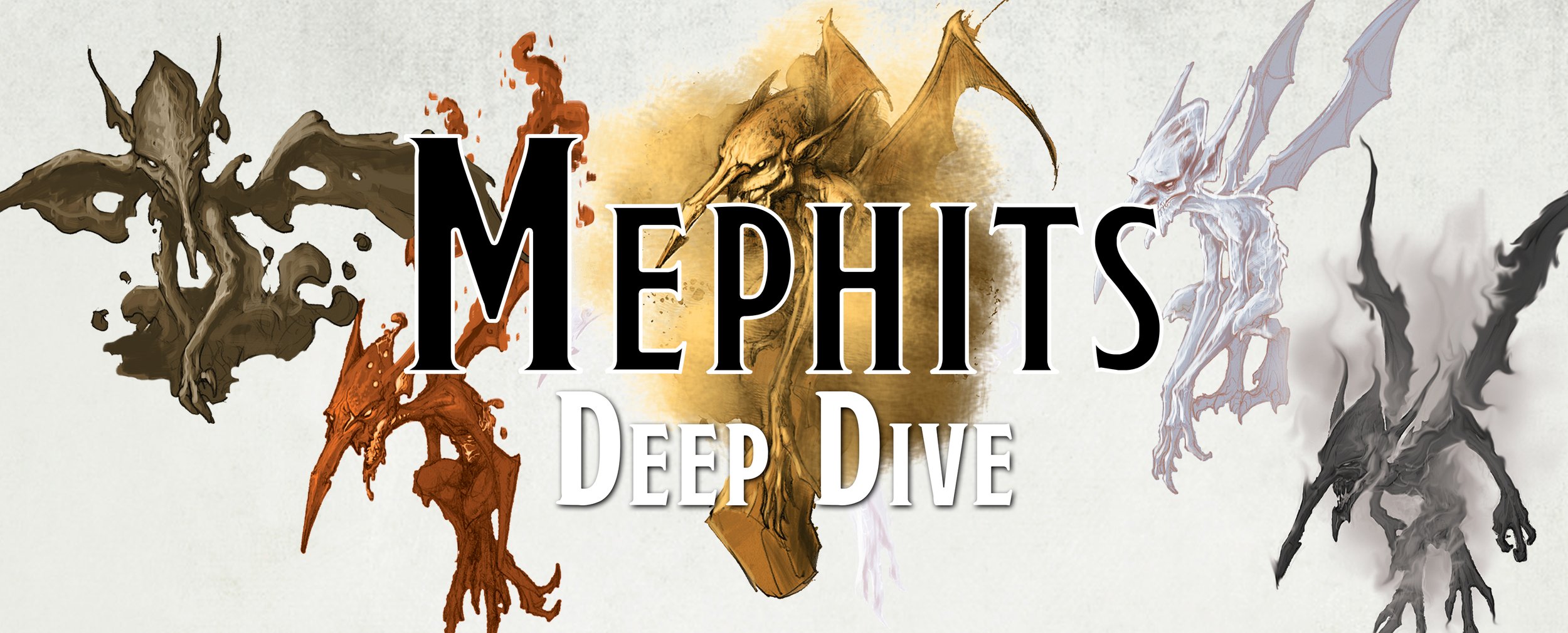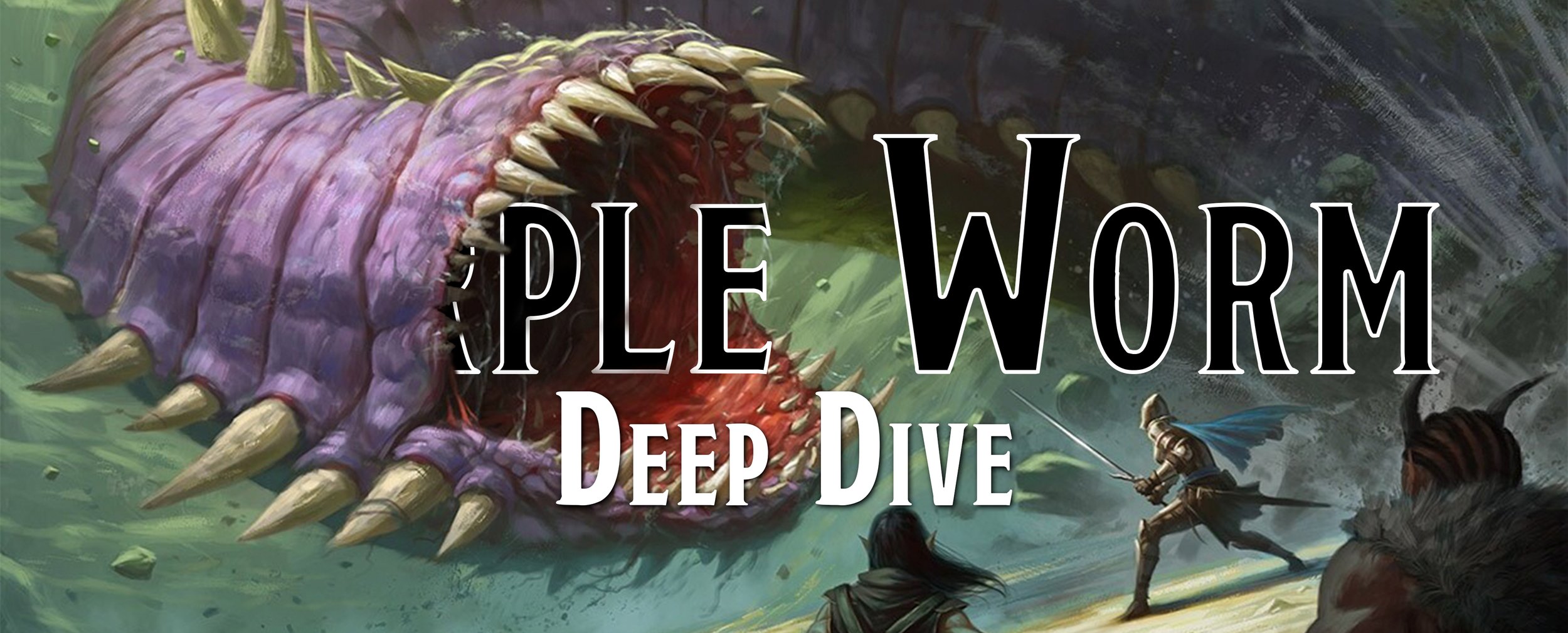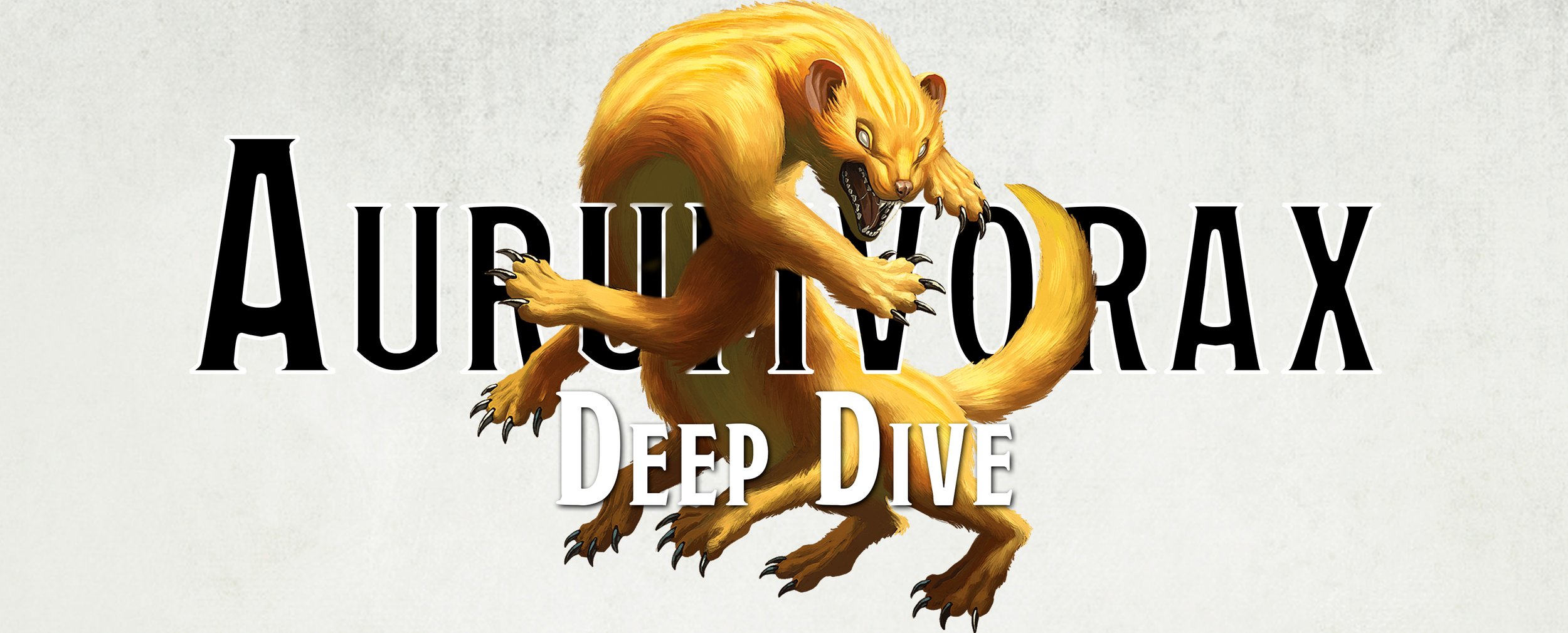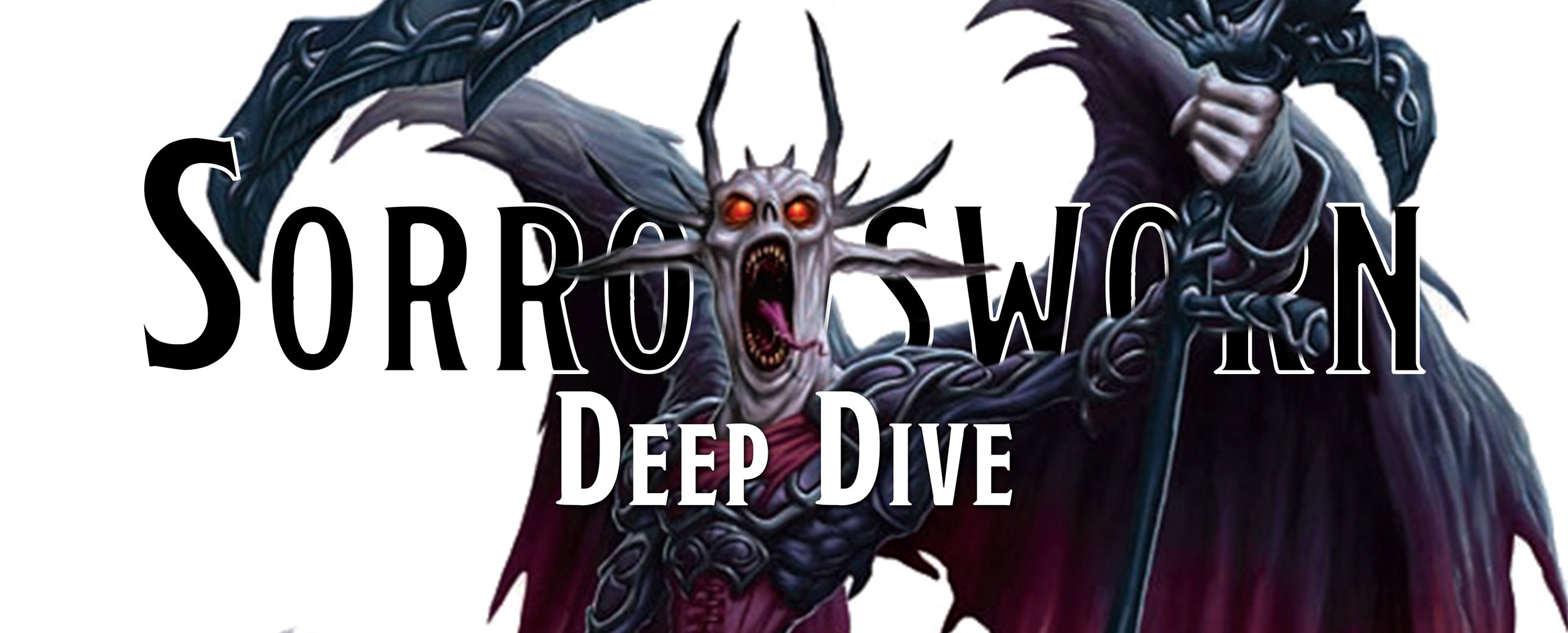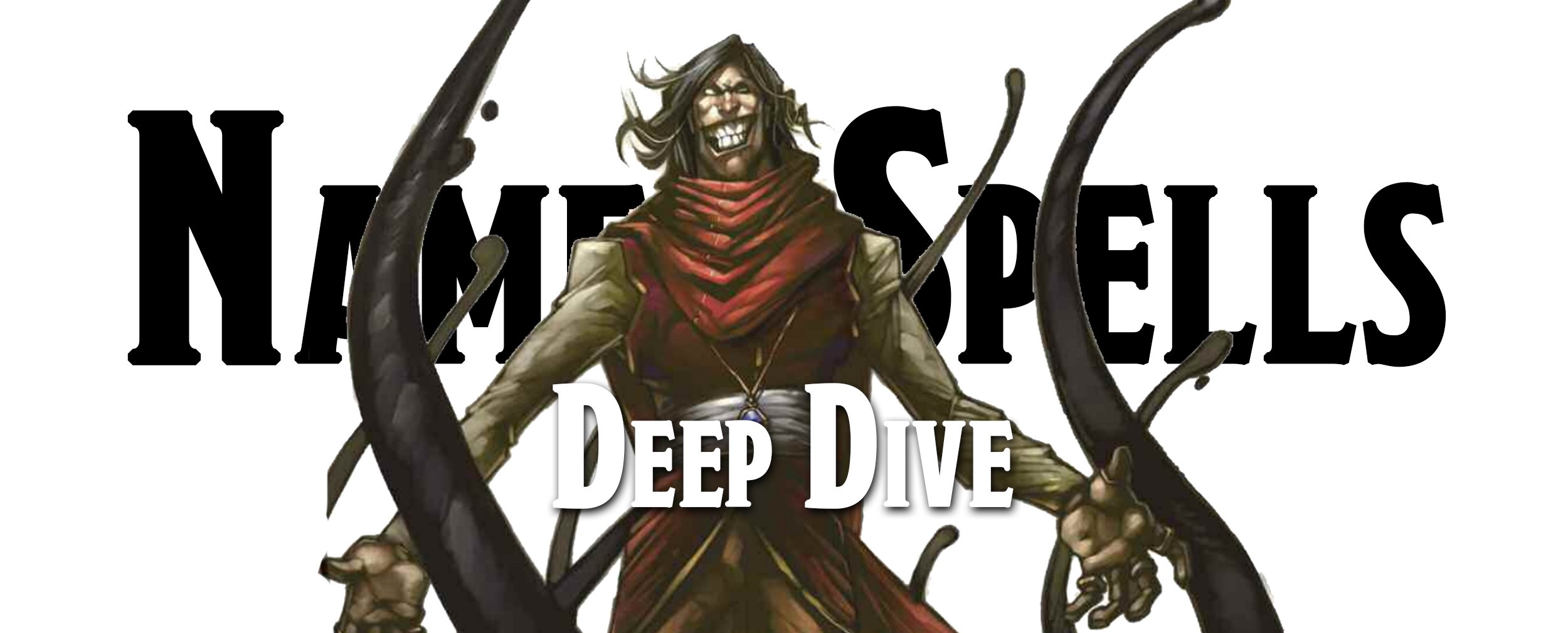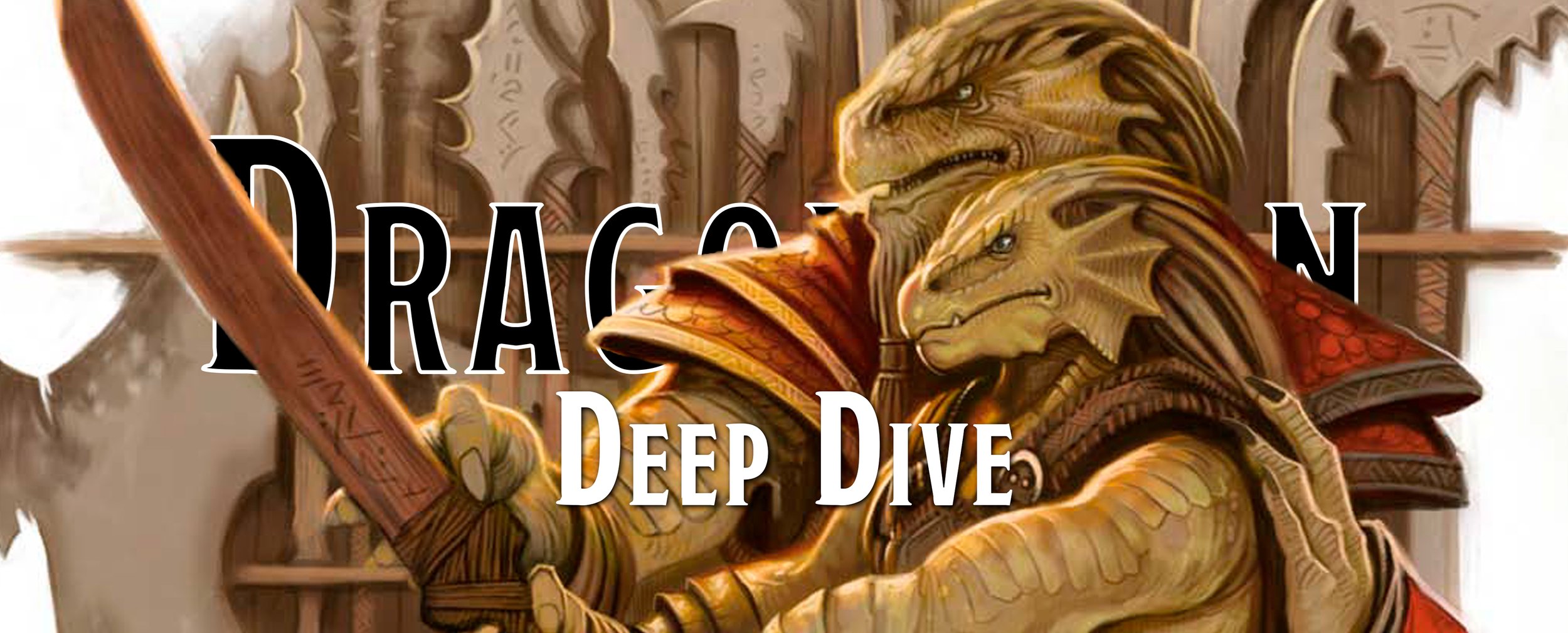Deep Dive - The Harpy
Back with a Greek classic monster, the Harpy is a horrific half-vulture and half-humanoid creature with a dark craving for flesh. They seem to be suffering from a case of mistaken identity, sharing the same attributes that the sirens from Greek classics have. They use their beautiful songs to lure in travelers, sailors, merchants, and others into dangerous situations before launching a vicious attack, ripping their victims to shreds.
These grotesque creatures may have once been formed by a curse from the gods or perhaps it was a justly deserved curse that transformed them into hunters who lure the weak-willed to their death. They are creatures of slaughter, and we pity any who stumbles across a group of these singing, vile predators.
OD&D - Harpy
No. Appearing: 2-12
Armor Class: 7
Move: 6/15
Hit Dice: 3
% in Lair: 20%
No. of Attacks: 2 claws/1 weapon
Damage/Attack: 1-3/claw, 1-6/weapon
Treasure: C
First found in the Greyhawk Suppliment (1975), the Harpy is described as a creature having the lower body of an eagle and the upper body of a human female. They hate all of mankind, and similar humanoids, going out of their way to kill as many as they can whenever they happen to stumble across them. Their preferred method is using their claws to rip you to shreds, followed up by using a weapon. While no specific weapon is mentioned for the Harpy, one imagines they might be wielding a club or shooting a short bow while they fly around your head.
Blackmoor Supplement, 1975 TSR Inc.
The Harpy also have a special charm ability they can use to enchant a creature through the power of song. It seems as if this edition combines the powers of the Harpy and the sirens into a single ferocious monster, or it could be that they got them mixed up. Regardless of why they can sing, their songs are powerful and anyone who hears it, with no definite range provided, must attempt to save against magic. If a creature fails to resist the song, they begin heading to the nearest, singing Harpy and presenting themselves to it. Once you arrive, the Harpy will then reach out and touch you, at which point, you are charmed.
But maybe being charmed isn’t too bad. Charm person and charm monster, the spells, simply state that the target is completely under the caster’s influence. This is pretty ambiguous, but if you are a really smart individual, you can make a new save against the charm effect once per day. If you are a big dumb-dumb, you have to wait a month before attempting the save again. Of course, this is greatly dependent on what the Harpy does to you. Once you are charmed, the Harpy then kills you and eats you, so no chance for a save despite your big brains. While that isn’t great, it could be worse, they could eat you and then kill you.
Basic D&D - Harpy
Armor Class: 7
Hit Dice: 3*
Move: 60’ (20’), Flying 150’ (50’)
Attacks: 2 claws/1 weapon + special
Damage: 1-4/1-4/1-6 + special
No. Appearing: 1-6 (2-8)
Save As: Fighter: 3
Morale: 7
Treasure Type: C
Alignment: Chaotic
XP Value: 50
Found in the Holmes Box Set (1974), the Moldvay/Cook Basic Box Set (1981), and the BECMI Basic Rules Box Set (1983), the Harpy remains much the same as its previous incarnation. One item of note is that the description clarifies the upper half-female form is hideously ugly. Apparently, the writers disagreed with Greek poet Hesiod who described Harpies as lovely feathered maidens. They must have been fans of Aeschylus, another Greek writer, who described them as hideous beings. Being doomed to being half-human/half-eagle is tragedy enough, so we feel like Aeschylus is just piling on at this point.
The Harpy’s abilities remain the same. They will sing you a beautiful song, and if you are unable to make the save, you start walking toward that sweet, sweet music. This edition's information on being charmed is a bit more developed and states you are unable to make decisions, you can’t attack or harm the charming creature, and you must obey simple commands the monster makes so long as you share a language. If you don’t speak the same language, then you just stand there and protect your new best friend from harm. Don’t even think about trying to get cheeky, as you are far too confused to use any spells or magic items. Your charmed condition can be ended if it is dispelled or if the charming monster dies, but short of that, you are just stuck there helping out your new best friend kill your old best friends.
So if you do hear their beautiful songs, and don’t succeed against the music, you’ll make your way to them as fast as possible. Once you reach the Harpy, there is good news. It rips you to shreds with its talons and eats you. Oh, did we forget to tell you that it was good news for the Harpy? Sorry about that.
AD&D - Harpy
Frequency: Rare
No. Appearing: 2-12
Armor Class: 7
Move: 6”/15”
Hit Dice: 3
% in Lair: 25%
Treasure Type: C
No. of Attacks: 3
Damage/Attack: 1-3/1-3/1-6
Special Attacks: Singing & charm
Special Defenses: Nil
Magic Resistance: Standard
Intelligence: Low
Alignment: Chaotic Evil
Size: M
Psionic Ability: Nil
Monster Manual, 1977 TSR Inc.
The Harpy appears in the Monster Manual (1977) and has a bit of difference in its description. Their bodies are that of a vulture while their upper torso and head are that of a female human. They are still vile creatures, loving the taste of flesh and killing any creature they come across with a voracious appetite. They only speak their language, so their songs, while quite beautiful, are impossible to understand unless you know Harpy.
There is now a mention of sirens, stating that any Harpy that lives along the coast is often called a siren with no difference between the two of them, though we can only imagine that ancient Greeks might have some disagreements about combining the creatures. No matter what you call them though, the Harpy still lures you in with their beautiful songs. Once you get hooked to the beat, you begin proceeding towards the Harpies, though it doesn’t specify if you are charmed by the song, only that when they touch you do you become charmed. This might mean that while yes, you have to walk toward them, maybe you can still shoot off a few spells before the Harpy touches you and you become charmed.
Though, let’s say you and twenty of your best friends are put upon by Harpies and all of you fail the save. You are then charmed, tortured, killed, and then feasted on, but that’s a lot of food to eat. What happens if the Harpies get full and no longer want to eat since they are watching their figure? Well, they’ll still torture and kill you, but now they’ll poop on anything they don’t immediately eat. We guess Harpies aren’t known for their ability to share.
Dragon #115, November 1986 TSR Inc.
Dragon #115 (November 1986) brings out two articles on the Ecology of the Harpy, the first being Songs of Beauty… written by Barbara Curtis followed by …Songs of Death by Ed Greenwood. These two articles provide additional lore on the Harpy, how they operate, and the best ways of fighting against them. In Curtis’ article, a ranger named Colin is seeking advice from a silver-haired sage, D’driand, on how to best deal with Harpies. While Colin is provided a trove of information, like how male and female Harpies are identical in appearance but different in biology, that they lay a clutch of twenty eggs at a time, and more; this is all undone by the end of the article where it is revealed that D’driand is actually working with the Harpies and gave Colin a spell scroll that will make him and his companions more susceptible to the Harpy songs, helping out his ally, Thanata, an actual Harpy.
The article also states that elves are rather resistant to Harpy songs, and so their flesh is seen as a delicacy by the carnivorous Harpies. In addition to that, while Harpies will eat anything, they will only do so if they are in a famine, only eating their vegetables when forced to by pangs of hunger. In addition, Harpies have no use for treasure so don’t go after them and expect to find a large hoard at the end of it all. They only take trinkets as trophies of their kills, and it could be as small as a lock of hair or a simple wooden ring that is easy for them to carry back to their roosts.
Greenwood’s article focuses on how Harpies attack their prey, and how their charming abilities work and affect other creatures. Bards are surprisingly resilient to their songs, though someone sleeping is almost guaranteed to fail against the power of their songs as it requires severe mental control to keep yourself from following to their voice. Once you fail against the song, you are only lightly charmed, drawn to be closer to them, and willing to hear what they have to say, especially if it’s more music. The Harpies use this to their advantage to have you drop your weapons or lead you into a more desirable place for a trap. Once they attack, their charming songs hold on you will instantly snap, so they’ll do what they can to make sure they have an early advantage. Once again, their touch is far stronger when it comes to charming you, and so they’ll try and get you to come close enough for them to touch you, which has the same effects as a charm monster spell, meaning you’ll do everything you can to protect the Harpies, even when they stab you in the back with their talons and feast on you.
2e - Harpy
Climate/Terrain: Temperate, tropical land or coast
Frequency: Rare
Organization: Flock
Activity Cycle: Day
Diet: Carnivore
Intelligence: Low (5-7)
Treasure: R (C)
Alignment: Chaotic Evil
No. Appearing: 2-12 (2d6)
Armor Class: 7
Movement: 6, Fl 15 (C)
Hit Dice: 7
THAC0: 13
No. of Attacks: 3
Damage/Attack: 1-3/1-3/1-6 or 1-3/1-3/weapon
Special Attacks: Singing and charm
Special Defenses: Nil
Magic Resistance: Nil
Size: M (6’)
Morale: Elite (13-14)
XP Value: 975
Monstrous Compendium Vol.1, 1989 TSR Inc.
We come across the Harpy in the Monstrous Compendium Vol. 1 (1989) and the Monstrous Manual (1993) and are given a bit more detail to go on. The Harpy’s lower half is still that of a vulture while their upper torso is that of a young human female, though one that is quite ugly and unkempt. Grooming is not a major priority for these creatures, and we aren’t sure that any Harpy through history has ever owned a hairbrush. Showering is also a big no for them and a foul odor follows the Harpy wherever they may go, perverting whatever they touch. They still speak their own language, which is a horrible collection of harsh bird-like sounds, and a rare few have picked up other languages. Unlike the previous editions, there is even a chance that the Harpy may wear some tattering clothing or shiny trinkets. Hygiene may not be important to them, but accessorizing is.
Harpies become more like their siren cousins than ever before, as their natural habitat is near the coastlines and along naval shipping routes. They live in rank caves, littered with bones and discarded trinkets of its victims, fouling the area so that no other creature would ever visit them. Just as with personal hygiene, housekeeping is not something they practice, and the filth of a Harpy’s lair can be several feet thick. They remain in these living conditions for a long as the nearby food supply remains bountiful.
No one knows if male Harpies exist as none have ever been seen, instead, they appear to reproduce by the females just deciding to lay a single egg once every other year. While all life is beautiful, the Harpies tend to disagree as motherhood is not in their repertoire, and the offspring are on their own to survive. Until they are old enough to hunt, they live off scraps of rotten meat and filth left behind by the adults.
Monsterous Manual, 1993 TSR Inc.
Harpies do not play well with each other and there is no social structure to speak of. Even in victory, the Harpies will find something to disagree on, like how long you should torture someone before eating them. These arguments often break out over who gets the most scrumptious morsel after they have slaughtered their prey or maybe who gets a shiny trinket that they’ll forget about by tomorrow. To decide who gets what, they will attack each other to the death. Win, and you win the argument and whatever you were fighting over. Lose, and you become a meal for the other Harpies.
Their singing now becomes their most potent ability in the Harpy’s arsenal. Once you fail against their beautiful voice, you’ll do everything in your power to rush right up and watch as they continue to sing and rip out your throat. If you do happen to be planning to fight these creatures, purchase some wax and shove it in your ears before you go to fight them. Once you hear the music, you can’t unhear it and you become charmed if you fail your save against it. So long as the Harpy continues to sing, you’ll stay under their sway, and they have gotten quite adept at singing and killing at the same time.
Now in the past, their touch was the most dangerous part facing off against them as it was similar to a charm monster spell, but now it is much less potent. Instead, when they touch you, and you fail a saving throw against it, you just stand mesmerized from anywhere from 21 to 30 hours, unable to move or react to anything. It's a less potent effect simply because they can’t give you orders and you won't do anything to protect them, but it’s probably good for them as they can rest their vocal cords for a full day and just let you stand around in amazement at how wonderful these creatures truly are. Then they kill you.
3e/3.5e - Harpy
Medium Monstrous Humanoid
Hit Dice: 7d8 (31hp)
Initiative: +2
Speed: 20 ft. (4 squares), fly 80 Ft. (average)
Armor Class: 13 (+2 Dex, +1 natural), touch 12, flat-footed 11
Base Attack/Grapple: +7/+7
Attack: Club +7 melee (1d6)
Full Attack: Club +7 melee (1d6) and 2 claws + 2 melee (1d3)
Space/Reach: 5 ft./5 ft.
Special Attacks: Captivating song
Special Qualities: Darkvision 60 ft.
Saves: Fort +2, Ref +7, Will +6
Abilities: Str 10, Dex 15, Con 10, Int 7, Wis 12, Cha 17
Skills: Bluff +11, Intimidate +7, Listen +7, Perform (oratory) +5, Spot +3
Feats: Dodge, Flyby Attack, Persuasive
Environment: Temperate marshes
Organization: Solitary, pair, or flight (7–12)
Challenge Rating: 4
Treasure: Standard
Alignment: Any chaotic evil
Advancement: By character class
Level Adjustment: +3
Monster Manual, 2003 WotC
Found in the Monster Manual (2000/2003), the Harpy faces a few new challenges when it comes to hunting its prey. The description changes, and now our Harpy is a half-human and half reptilian monster. The human upper half is an evil-faced old person, with no mention that they are all female. Clothing is a no-go once again, as is any semblance of personal hygiene. The Harpy’s face is angry, dirty, and twisted in pure evil. Pure black eyes peer out with burning hatred at the world, seeking and searching for something to feed on. Its reptile lower half comes with leathery wings and wicked talons that are meant for ripping flesh from bone.
It still sings to charm its victims and once they are charmed, the Harpy slowly tortures its food. It’s kind of like a cat, playing with its food, except you get a show and it gets dinner. This torture includes lots of biting and clawing, and once you are have stopped being an entertaining toy, it will stop singing, which finally allows you to react to the Harpy instead of just standing there, and then put you out of your misery. Followed by a delicious meal of you, and then probably a nap after a long day of hard work. You’ll notice that they can’t just touch you and charm you, only their voice can charm you. They’ve lost the ability to hit someone so hard that they become charmed by them, which we can only imagine makes life more difficult for them as now they can’t even rest their vocal cords while entertaining guests.
Once charmed, the Harpy slowly tortures you since no one ever told them not to play with their food. The torture includes biting and clawing you. And just for fun, it may pummel you with the giant bone it is using as a weapon. Once it has had enough fun, the Harpy will release you from its Captivating Song and put you out of your misery. And then eat you.
We are also introduced to a more mercenary Harpy and given the example of the Harpy Archer, a creature who isn’t any more pleasant than a standard Harpy but is now wielding a bow. These creatures are often called wandering bandits and are experts with their longbows, often hired as mercenaries by those that can afford them. If work is scarce, they will resort to simple extortion and “protection” services, forcing merchants and artisans to pay for the privilege of having the Harpy not attack them or sing to them.
Savage Species, 2003 WotC
The Harpy does get one last appearance in Savage Species (2003) where the Siren prestige class is listed, as well as PC and NPC character creation rules are found to make a playable Harpy character. The Siren class is available to anyone who has a mind-affecting ability that works through sound, so a Harpy is a perfect candidate for this prestige class as that’s their entire thing. A Siren gains new ways of using their voice, like singing songs of despair, idiocy, weakness, and more; allowing them to cause their voice to hurt, harm, and debuff their victims in a wide variety of ways. Of course, their voice isn’t very discerning and any allies within 300 feet of them are also affected, but you can’t make an omelet without killing your party members first and then eating their corpses.
If you are hoping to make a Harpy, get ready for all the insults this book will levy at you. First, you are called filthy birdfolk followed up with a big -4 hit to your Intelligence. There are ten total levels to becoming a true Harpy and you don’t even get your beautiful song until 4th level and it only has an effective range of 10 feet. As you level up within the Harpy class, as you don’t get all of the abilities of the Harpy at first but instead must earn them, you get faster at flying, claw attacks, and your song becomes stronger and its range of effect increases, which can be rather annoying for your party members as it has an effective range of 300 feet at 10th level, meaning that they are probably always going to be captivated by you. If you are hoping to betray them later on, then it’ll probably work out great for you.
4e - Harpy
Level 6 Controller
Medium fey humanoid / XP 250
Initiative +5 / Senses Perception +5
HP 71; Bloodied 35
AC 20; Fortitude 17, Reflex 17, Will 219
Resist 10 thunder
Speed 6, fly 8 (clumsy)
Claw (standard; at-will) +11 vs. AC; 1d8 + 2 damage.
Alluring Song (standard; sustain minor; at-will) ✦ Charm Close burst 10; deafened creatures are immune; +12 vs. Will; the target is pulled 3 squares and immobilized (save ends). When the harpy sustains the power, any target that has not yet saved against the effect is pulled 3 squares and immobilized (save ends).
Deadly Screech (standard; recharge ⚄ ⚅ ) ✦ Thunder Close burst 4; +12 vs. Fortitude; 1d6 + 4 thunder damage, and the target is dazed (save ends).
Alignment Evil / Languages Common
Skills Stealth +10
Str 15 (+5) Dex 15 (+5) Wis 14 (+5) Con 15 (+5) Int 10 (+3) Cha 19 (+7)
Monster Manual, 2008 WotC
The Harpy lands in the Monster Manual (2008) for 4th edition and comes with a few minor changes, as well as a new style of Harpy. They are still renowned for their singing and gain a new way to use their melodic voice, by screeching so loudly that it can burst your eardrums and cause you to become dazed and discombobulated. Of course, they would prefer if you just scooted closer to it and pay attention without having to hurt you, yet.
This is also the first time that the Harpy gains resistance to damage, and it is thunder damage. We can only assume it’s because of their screech, that way they don’t hurt each other when they start screeching at the food too loudly.
We are introduced to the Bloodfire Harpy, and while they aren’t any nicer than a regular Harpy, their song carries a little different tune. Instead of charming you, the Bloodfire’s song literally causes your blood to boil. We know that we can get so angry that we say our blood is boiling, but it is a whole different story for it to actually start happening. These Harpies also employ a cloud of ash to obscure themselves if you have any bright ideas like walking up and trying to hit it with your sword, which is just rude of you.
While the Harpies can still fly, they aren’t known as graceful. Once they charm you, they usually land before attacking with their claws. It soon flaps away if it starts getting ganged up as it has no interest in a fair fight, let alone a fight swinging out of its favor. They no longer speak Harpy, as their language has fallen by the wayside, probably because people got tired of trying to learn such a screeching language. Their new language is that they all now speak common, so it’s easier for you to put lyrics to the beautiful but deadly music they produce. Harpies can be male or female and will share a nest in the name of reproduction only, as the male ditches the mom and eggs as soon as possible, not even sticking around to make up an excuse about picking up a bit of fresh meat for the nest and that they’ll be back soon.
A bit of new history for the Harpy is provided which focuses on the creation of the Harpy and how they came about. In the distant past, there was once an evil elf witch-queen who ruled over a great swath of territory. She would use a magical tiara to transform into a giant golden eagle, which allowed her to spy on her people, though we have to assume everyone knew when she was about seeing as she is a giant, golden eagle. As you might have guessed, a mighty hero rose to defeat this nosey queen, breaking the tiara and forcing her into exile where she could never transform. She, and her spawn, were also cursed to become half-bird creatures who would become known as Harpies.
5e - Harpy
Medium monstrosity, chaotic evil
Armor Class 11
Hit Points 38 (7d8+7)
Speed 20 ft., fly 40 ft.
STR 12 (+1) DEX 13 (+1) CON 12 (+1 ) INT 7 (-2) WIS 10 (+0) CHA 13 (+1)
Senses passive Perception 10
Languages Common
Challenge 1 (200 XP)
Multiattack. The harpy makes two attacks: one with its claws and one with its club.
Claws. Melee Weapon Attack: +3 to hit, reach 5 ft., one target. Hit: 6 (2d4 + 1) slashing damage.
Club. Melee Weapon Attack: +3 to hit, reach 5 ft., one target. Hit: 3 (1d4 + 1) bludgeoning damage.
Luring Song. The harpy sings a magical melody. Every humanoid and giant within 300 feet of the harpy that can hear the song must succeed on a DC 11 Wisdom saving throw or be charmed until the song ends. The harpy must take a bonus action on its subsequent turns to continue singing. It can stop singing at any time. The song ends if the harpy is incapacitated. While charmed by the harpy, a target is incapacitated and ignores the songs of other harpies. If the charmed target is more than 5 feet away from the harpy, the target can take the Dash action on its turn to move toward the harpy by the most direct route. It doesn't avoid opportunity attacks, but before moving into damaging terrain, such as lava or a pit, and whenever it takes damage from a source other than the harpy, a target can repeat the saving throw. A creature can also repeat the saving throw at the end of each of its turns. If a creature's saving throw is successful, the effect ends on it. A target that successfully saves is immune to this harpy's song for the next 24 hours
Monster Manual, 2014 WotC
The Harpy returns in the Monster Manual (2014) with all new lore that doesn’t appear in any form in the previous editions. These unfortunate creatures are the result of a divine curse placed upon a poor elf that cursed the gods when she couldn’t get one of them to love her. To start from the beginning, a young elf maiden hears a beautiful bird song and goes to investigate, where she stumbles upon a clearing where a reclusive elven god known as Fenmarel Mestarine is also listening to the noise. Noticing her, he flees, and his divine presence is enough to fill the maiden with yearning and she claims that he stole her heart, even if all he did was run away.
This sudden departure caused quite a bit of anguish for the maiden who cried out for help. Another elven deity, Aerdrie Faenya, the elven goddess of the sky, heard her pleas and, appearing as a bird, teaches her a song of beauty and seduction. The maiden then uses her new power and attempts to draw back Fenmarel Mestarine, which fails, causing the maiden to grow angry. She then lashes out, cursing the gods, but it backfires as she is then twisted and corrupted by the same curse. She is transformed into the first Harpy, her desire and need for love turn into a ravenous appetite for flesh.
Depending on how you look at this story, it could be one where the gods have created a horrible monster in a young elf maiden. Then again, maybe the elf maiden was a bit too needy for a stranger she only got a glance of. The story is written as pretty ambiguous, so who knows what truly happened back then. All we do know is that if you hear the song of beautiful singing, it's too late and you’re about to be a Harpy’s next meal.
The Harpy’s song is the most beautiful sound in the world, that it can cause men to throw themselves off of cliffs and, strangely enough, even giants are into it. This is the first edition where giants are specifically called out. Most of the time before, it was just humanoids or all creatures, but not Harpies, that would boogie down to the Harpy song. These feathered creatures are still the cowards they always were, not wishing to fight fairly and instead rely on their song to draw creatures in and across dangerous terrain. They don’t want to get into a fight, but would rather have their victim walk off a cliff or similar terrain. Not only does this keep the Harpy from having to get blood all over themselves, but it tenderizes the meat as the fall is sure to soften your flesh.
Harpies live along coastal shorelines, preferring places with cliffs where they could build their horrific nests. Their lairs are squalid affairs but are usually filled with all sorts of trinkets and shiny things, with even some goodies buried deep within the filth and offal of their homes. They take these things as trophies, even if they have no practical use, merely acting as a remembrance of how they ripped out your throat after torturing you for days. Harpies love trophies, the shinier the better, though a Harpy will gladly take a tuft of hair, bones, or maybe some other body part if you happen to be rather lacking in material possessions or if a meaner Harpy took your nice stuff first.
Not much else changes for the Harpy, though the Matriarch Harpy does make an appearance in the Ghosts of Saltmarsh (2019) adventure book. She is a meaner, and more magically gifted, Harpy who is capable of using illusion magic to make herself appear like a humanoid of her choice. Also, the matriarch can send visions of grandeur to nearby creatures, causing them to become paralyzed as they gaze at their visions in wonder and filled with avarice. Sadly, she is barely more than a random encounter in the adventure Tammeraut’s Fate and so almost nothing else is revealed about what being a Harpy Matriarch is all about.
The Harpy has gone through few changes throughout the editions of Dungeons & Dragons, and it isn’t until the last few editions that anyone begins wondering how they came to be. They are best known for their beautiful voices, even if they appear as wretched songbirds with the old faces of humans. If you ever do hear some beautiful music, it’s already too late for you. We just hope, for your sake, that your death is swift and they don’t spend too many days torturing you.































